Why is the North Atlantic Oscillation More Predictable in December?
Abstract
1. Introduction
2. Data and Methods
3. Predictability Sources of the December NAO
3.1. Relationship between the North Atlantic SSTA Tripole and the NAO
3.2. Monthly Differences of Atmospheric Circulation Anomalies Related to the NAO
3.3. Relationship between the Stratospheric Circulation and the NAO
4. Discussion and Conclusions
Author Contributions
Funding
Acknowledgments
Conflicts of Interest
References
- Kakade, S.B.; Dugam, S.S. North Atlantic Oscillation and northern hemispheric warming. Indian J. Mar. Sci. 2006, 35, 205–209. [Google Scholar] [CrossRef]
- Hurrell, J.W.; Deser, C. North Atlantic climate variability: The role of the North Atlantic Oscillation. J. Mar. Syst. 2009, 78, 28–41. [Google Scholar] [CrossRef]
- Fu, C.B.; Zeng, S.M. The relations between the North Atlantic Oscillation on winter and summer drought/flood index in the east of China during the past 530 years. Chinese Sci. Bull. 2005, 50, 1512–1522. [Google Scholar] [CrossRef]
- Gong, D.Y.; Gao, Y.Q.; Guo, D.; Mao, R.; Yang, J.; Hu, M.; Gao, M.N. Interannual linkage between Arctic/North Atlantic Oscillation and tropical Indian Ocean precipitation during boreal winter. Clim. Dyn. 2014, 42, 1007–1027. [Google Scholar] [CrossRef]
- Li, J.; Fan, K.; Xu, Z. Links between the late wintertime North Atlantic Oscillation and springtime vegetation growth over Eurasia. Clim. Dyn. 2015, 1–14. [Google Scholar] [CrossRef]
- Zhou, B.; Cui, X. Interdecadal change of the linkage between the North Atlantic Oscillation and the tropical cyclone frequency over the western North Pacific. Sci. China Earth Sci. 2014, 57, 2148–2155. [Google Scholar] [CrossRef]
- Sung, M.K.; Kwon, W.T.; Baek, H.J.; Boo, K.O.; Lim, G.H.; Kug, J.S. A possible impact of the North Atlantic Oscillation on the east Asian summer monsoon precipitation. Geophys. Res. Lett. 2006, 33, L21713. [Google Scholar] [CrossRef]
- Ogi, M.; Tachibana, Y.; Yamazaki, K. Impact of the wintertime North Atlantic Oscillation (NAO) on the summertime atmospheric circulation. Geophys. Res. Lett. 2003, 30, 1704. [Google Scholar] [CrossRef]
- Czaja, A.; Frankignoul, C. Observed impact of Atlantic SST anomalies on the North Atlantic Oscillation. J. Clim. 2002, 15, 606–623. [Google Scholar] [CrossRef]
- Peng, S.L.; Robinson, W.A.; Li, S.L. North Atlantic SST forcing of the NAO and relationships with intrinsic hemispheric variability. Geophys. Res. Lett. 2002, 29, 4. [Google Scholar] [CrossRef]
- Han, Z.; Luo, F.F.; Wan, J.H. The observational influence of the North Atlantic SST tripole on the early spring atmospheric circulation. Geophys. Res. Lett. 2016, 43, 2998–3003. [Google Scholar] [CrossRef]
- Sutton, R.T.; Norton, W.A.; Jewson, S.P. The North Atlantic Oscillation-what role for the ocean? Atmos. Sci. Lett. 2000, 1, 89–100. [Google Scholar] [CrossRef]
- Robertson, A.W.; Mechoso, C.R.; Kim, Y.-J. The Influence of Atlantic Sea Surface Temperature Anomalies on the North Atlantic Oscillation*. J. Clim. 2000, 13, 122–138. [Google Scholar] [CrossRef]
- Mochizuki, T.; Awaji, T.; Sugiura, N. Possible oceanic feedback in the extratropics in relation to the North Atlantic SST tripole. Geophys. Res. Lett. 2009, 36, 5. [Google Scholar] [CrossRef]
- Deser, C.; Timlin, M.S. Atmosphere-ocean interaction on weekly timescales in the North Atlantic and Pacific. J. Clim. 1997, 10, 393–408. [Google Scholar] [CrossRef]
- Baldwin, M.P.; Cheng, X.H.; Dunkerton, T.J. Observed correlations between winter-mean tropospheric and stratospheric circulation anomalies. Geophys. Res. Lett. 1994, 21, 1141–1144. [Google Scholar] [CrossRef]
- Hansen, F.; Greatbatch, R.J.; Gollan, G.; Jung, T.; Weisheimer, A. Remote control of North Atlantic Oscillation predictability via the stratosphere. Q. J. R. Meteorol. Soc. 2017, 143, 706–719. [Google Scholar] [CrossRef]
- Scaife, A.A.; Karpechko, A.Y.; Baldwin, M.P.; Brookshaw, A.; Butler, A.H.; Eade, R.; Gordon, M.; MacLachlan, C.; Martin, N.; Dunstone, N.; et al. Seasonal winter forecasts and the stratosphere. Atmos. Sci. Lett. 2016, 17, 51–56. [Google Scholar] [CrossRef]
- Kunz, T.; Fraedrich, K.; Lunkeit, F. Impact of Synoptic-Scale Wave Breaking on the NAO and Its Connection with the Stratosphere in ERA-40. J. Clim. 2009, 22, 5464–5480. [Google Scholar] [CrossRef]
- Wang, L.; Ting, M.; Kushner, P.J. A robust empirical seasonal prediction of winter NAO and surface climate. Sci. Rep. 2017, 7, 9. [Google Scholar] [CrossRef]
- Tian, B.Q.; Fan, K. A skillful prediction model for winter NAO based on Atlantic sea surface temperature and Eurasian snow cover. Weather Forecast. 2015, 30, 197–205. [Google Scholar] [CrossRef]
- Saunders, M.A.; Qian, B.D. Seasonal predictability of the winter NAO from north Atlantic sea surface temperatures. Geophys. Res. Lett. 2002, 29, 2043. [Google Scholar] [CrossRef]
- Dunstone, N.; Smith, D.; Scaife, A.; Hermanson, L.; Eade, R.; Robinson, N.; Andrews, M.; Knight, J. Skilful predictions of the winter North Atlantic Oscillation one year ahead. Nat. Geosci. 2016, 9, 809–814. [Google Scholar] [CrossRef]
- Müller, W.A.; Appenzeller, C.; Schär, C. Probabilistic seasonal prediction of the winter North Atlantic Oscillation and its impact on near surface temperature. Clim. Dyn. 2005, 24, 213–226. [Google Scholar] [CrossRef]
- Yuan, S.; Luo, X.; Mu, B.; Li, J.; Dai, G. Prediction of North Atlantic Oscillation index with convolutional LSTM based on ensemble empirical mode decomposition. Atmosphere 2019, 10, 252. [Google Scholar] [CrossRef]
- Saito, N.; Maeda, S.; Nakaegawa, T.; Takaya, Y.; Imada, Y.; Matsukawa, C. Seasonal predictability of the North Atlantic Oscillation and zonal mean fields associated with stratospheric influence in JMA/MRI-CPS2. Sola 2017, 13, 209–213. [Google Scholar] [CrossRef]
- Ke, F.; Baoqiang, T.; Huijun, W. New approaches for the skillful prediction of the winter North Atlantic Oscillation based on coupled dynamic climate models. Int. J. Clim. 2016, 36, 82–94. [Google Scholar] [CrossRef]
- Xu, X.P.; Li, F.; He, S.P.; Wang, H.J. Subseasonal reversal of East Asian surface temperature variability in winter 2014/15. Adv. Atmos. Sci. 2018, 35, 737–752. [Google Scholar] [CrossRef]
- Zuo, J.Q.; Ren, H.L.; Li, W.J. Contrasting impacts of the Arctic Oscillation on surface air temperature anomalies in Southern China between early and middle-to-late winter. J. Clim. 2015, 28, 4015–4026. [Google Scholar] [CrossRef]
- Hu, Y.Y.; Tung, K.K.; Liu, J.P. A closer comparison of early and late-winter atmospheric trends in the northern hemisphere. J. Clim. 2005, 18, 3204–3216. [Google Scholar] [CrossRef]
- Zuo, J.Q.; Ren, H.L.; Wu, J.; Nie, Y.; Li, Q.P. Subseasonal variability and predictability of the Arctic Oscillation/North Atlantic Oscillation in BCCAGCM2.2. Dyn. Atmos. Oceans 2016, 75, 33–45. [Google Scholar] [CrossRef][Green Version]
- Huang, B.; Freeman, E.; Lawrimore, J.H.; Liu, W.; Peterson, T.C.; Smith, T.M.; Thorne, P.; Woodruff, S.; Zhang, H.M.; Banzon, P.V.F. Extended Reconstructed Sea Surface Temperature Version 4 (ERSST.v4), Part I. Upgrades and Intercomparisons. J. Clim. 2015, 28, 911–930. [Google Scholar] [CrossRef]
- Saha, S.; Moorthi, S.; Wu, X.; Wang, J.; Nadiga, S.; Tripp, P.; Behringer, D.; Hou, Y.-T.; Chuang, H.-y.; Iredell, M.; et al. The NCEP climate forecast system version 2. J. Clim. 2014, 27, 2185–2208. [Google Scholar] [CrossRef]
- Weisheimer, A.; Doblas-Reyes, F.J.; Palmer, T.N.; Alessandri, A.; Arribas, A.; Deque, M.; Keenlyside, N.; MacVean, M.; Navarra, A.; Rogel, P. ENSEMBLES: A new multi-model ensemble for seasonal-to-annual predictions-Skill and progress beyond DEMETER in forecasting tropical Pacific SSTs. Geophys. Res. Lett. 2009, 36, L21711. [Google Scholar] [CrossRef]
- Hurrell, J.W. Decadal trends in the North Atlantic Oscillation: regional temperatures and precipitation. Science 1995, 269, 676–679. [Google Scholar] [CrossRef]
- Cayan, D.R. Latent and sensible heat flux anomalies over the northern oceans: driving the sea surface temperature. J. Phys. Oceanogr. 1992, 22, 859–881. [Google Scholar] [CrossRef]
- Fan, K.; Wang, H.J.; Choi, Y.J. A physically-based statistical forecast model for the middle-lower reaches of the Yangtze River Valley summer rainfall. Chinese Sci. Bull. 2008, 53, 602–609. [Google Scholar] [CrossRef]
- Ting, M.F.; Lau, N.C. A diagnostic and modelling study of the monthly mean wintertime anomalies appearing in a 100-year GCM experiment. J. Atmos. Sci. 1993, 50, 2845–2867. [Google Scholar] [CrossRef]
- Rodwell, M.; Rowell, D.; Folland, C. Oceanic forcing of the wintertime North Atlantic Oscillation and European climate. Nature 1999, 398, 320–323. [Google Scholar] [CrossRef]
- Pan, L.L. Observed positive feedback between the NAO and the North Atlantic SSTA tripole. Geophys. Res. Lett. 2005, 32, 4. [Google Scholar] [CrossRef]
- Andrews, M.B.; Knight, J.R.; Scaife, A.A.; Lu, Y.; Wu, T.; Gray, L.J.; Schenzinger, V. Observed and simulated teleconnections between the stratospheric Quasi-Biennial Oscillation and Northern Hemisphere winter atmospheric circulation. J. Geophys. Res. Atmos. 2019, 124, 1219–1232. [Google Scholar] [CrossRef]
- Nie, Y.; Scaife, A.A.; Ren, H.-L.; Comer, R.E.; Andrews, M.B.; Davis, P.; Martin, N. Stratospheric initial conditions provide seasonal predictability of the North Atlantic and Arctic Oscillations. Environ. Res. Lett. 2019, 14, 7. [Google Scholar] [CrossRef]
- Baldwin, M.P.; Dunkerton, T.J. Stratospheric harbingers of anomalous weather regimes. Science 2001, 294, 581–584. [Google Scholar] [CrossRef] [PubMed]
- Black, J.; Johnson, N.C.; Baxter, S.; Feldstein, S.B.; Harnos, D.S.; L’Heureux, M.L. The predictors and forecast skill of Northern Hemisphere teleconnection patterns for lead times of 3-4 weeks. Mon. Weather Rev. 2017, 145, 2855–2877. [Google Scholar] [CrossRef]

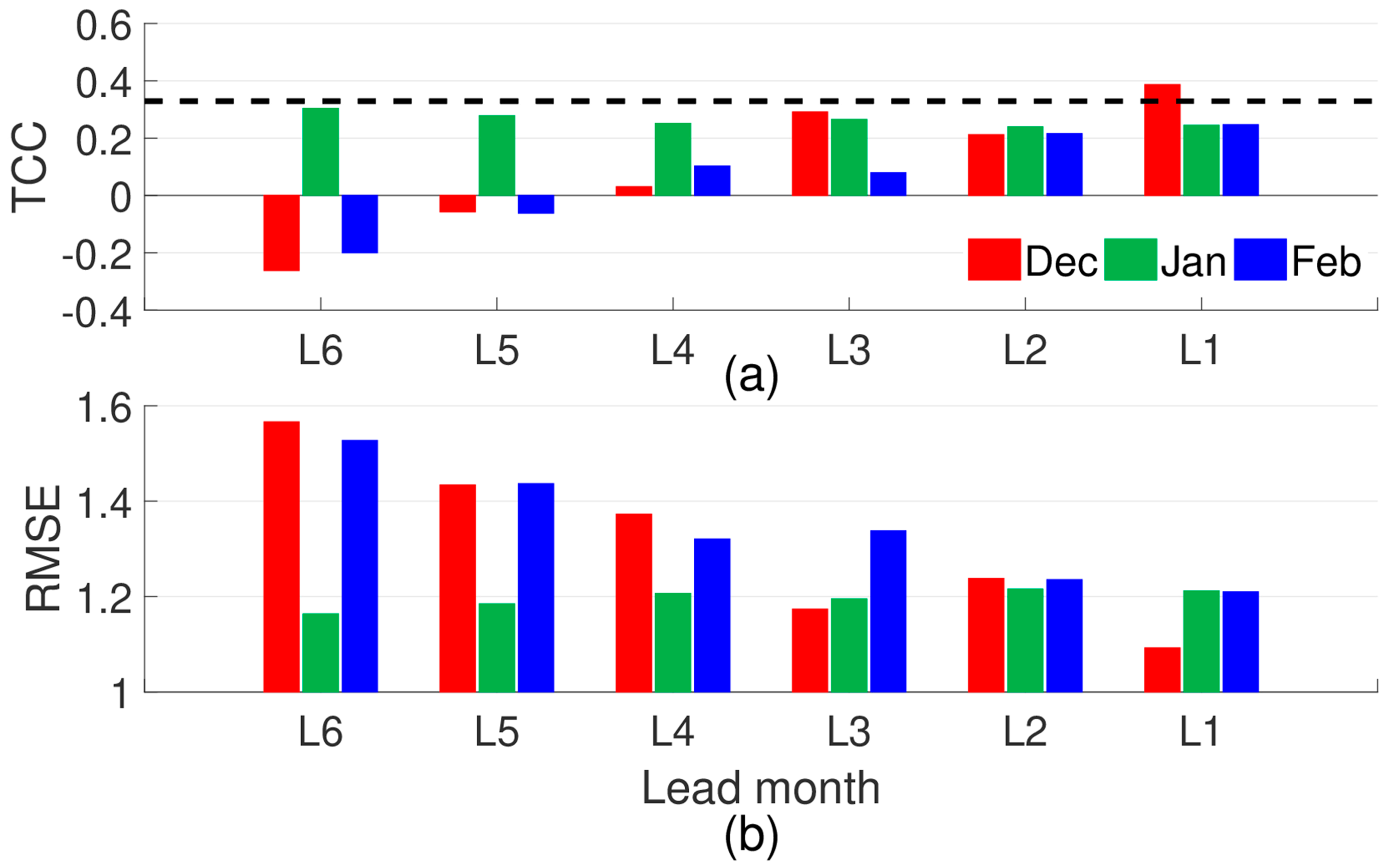
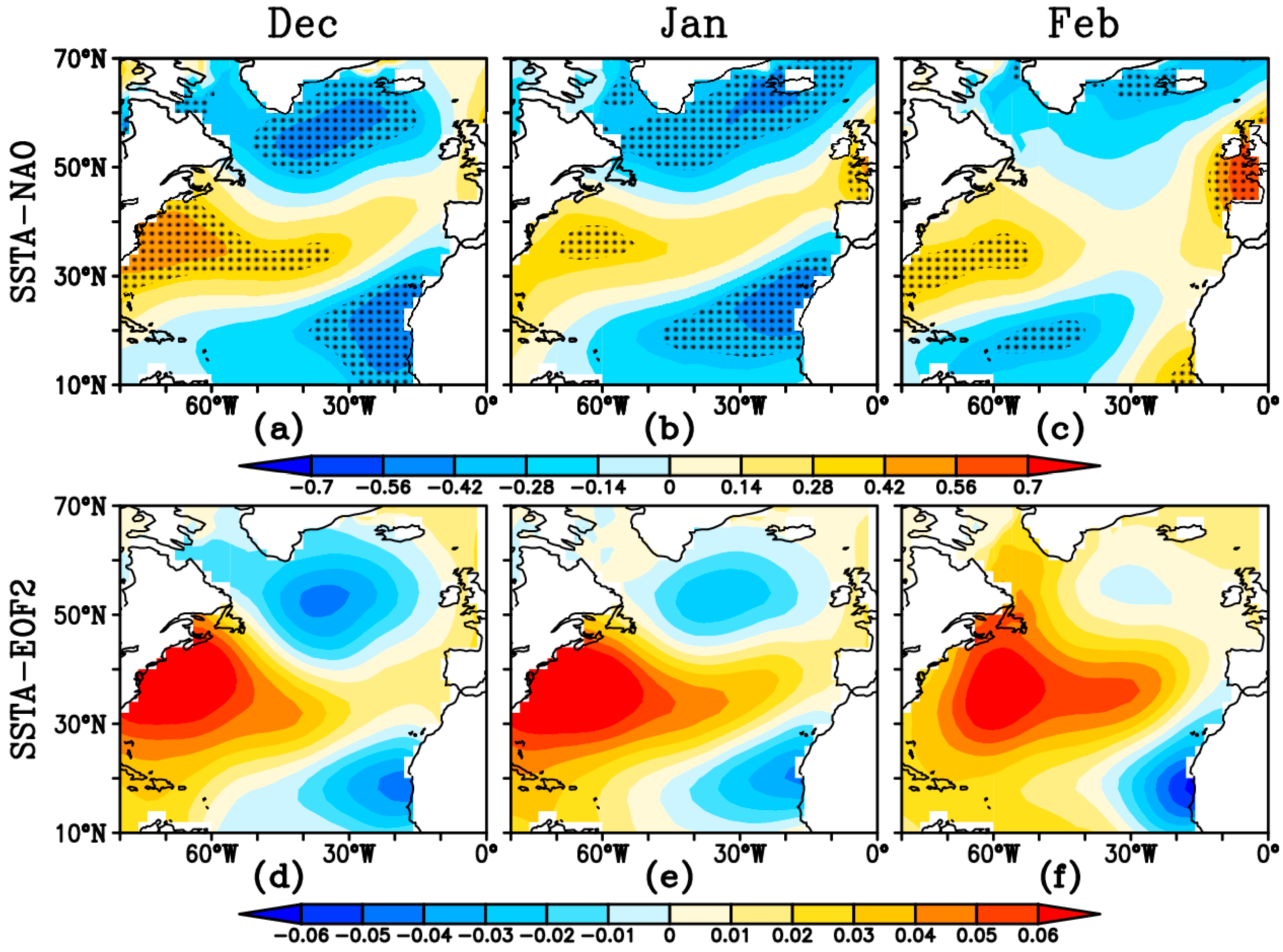

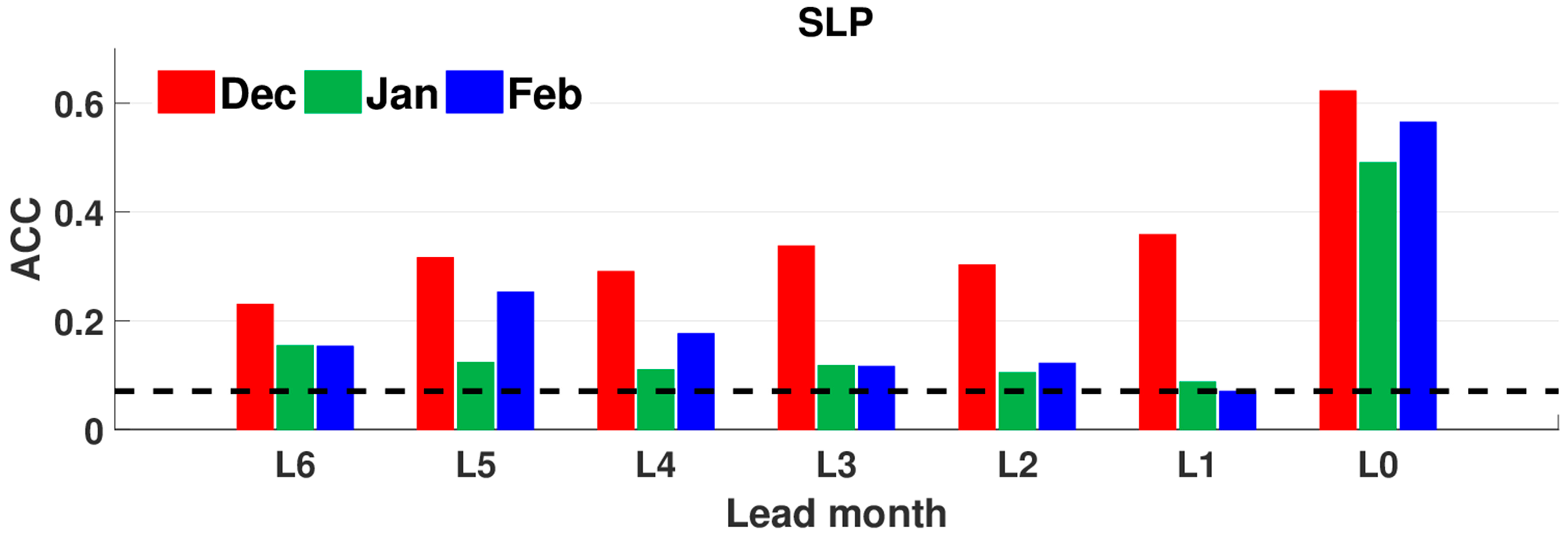

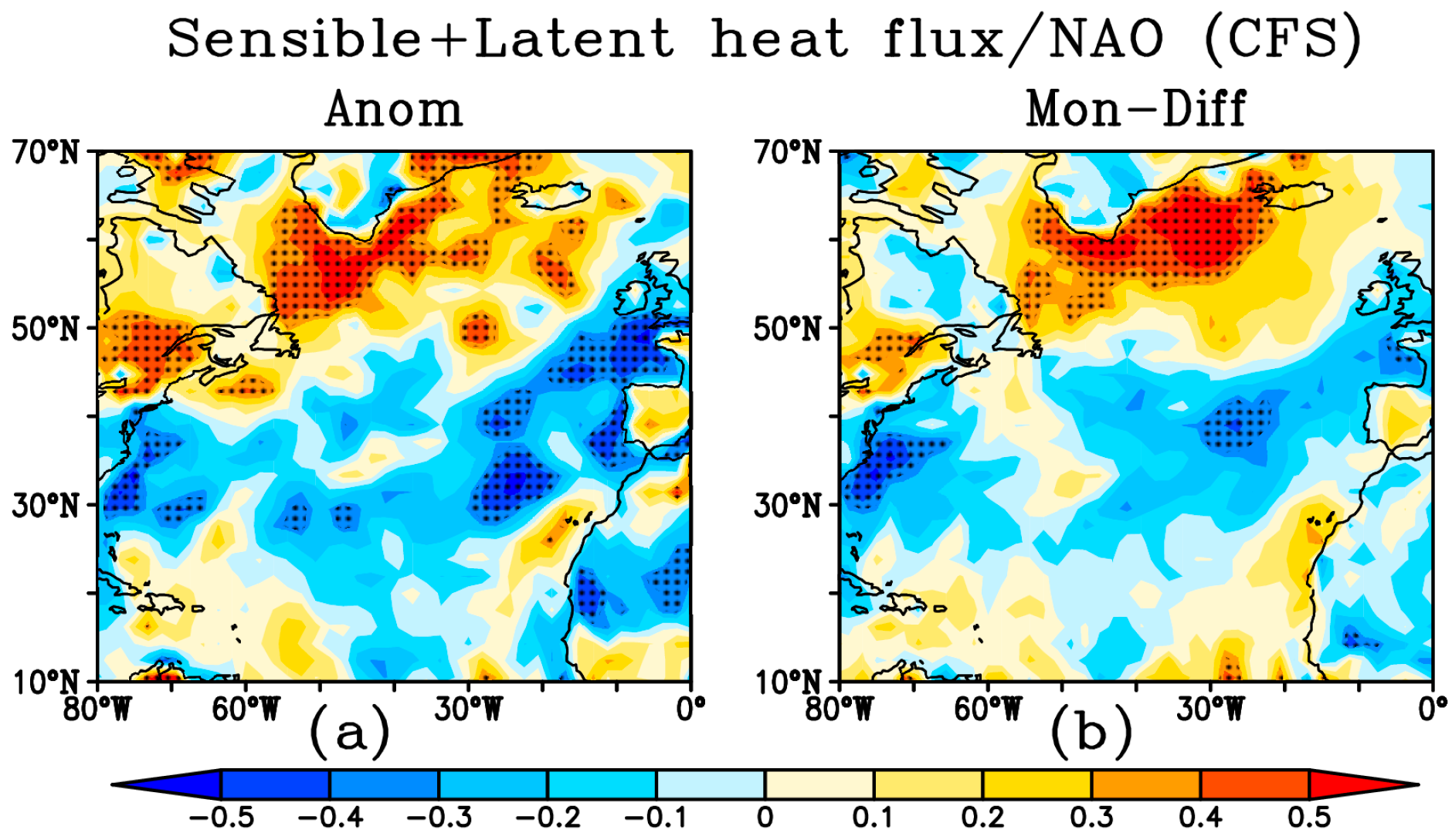
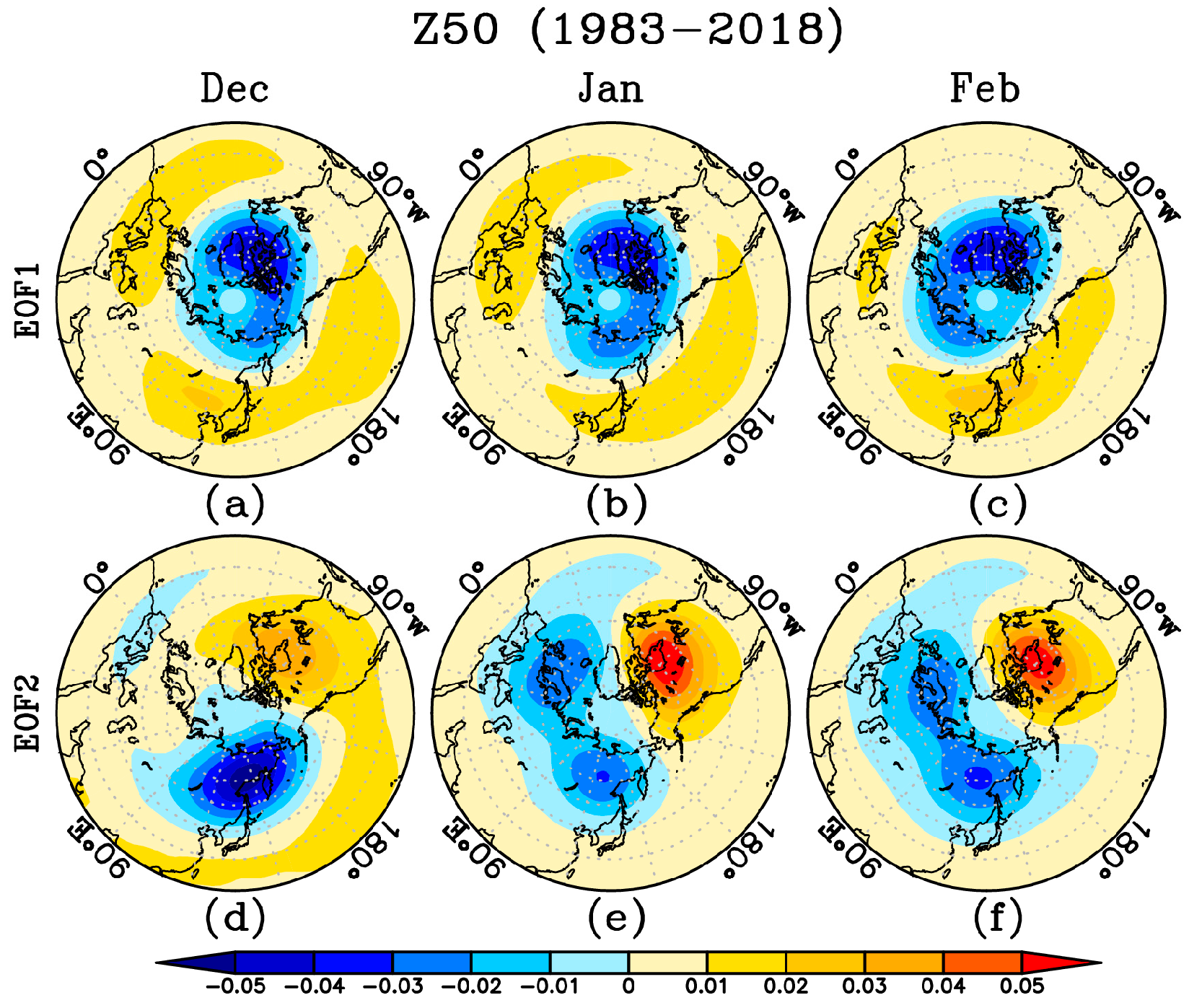
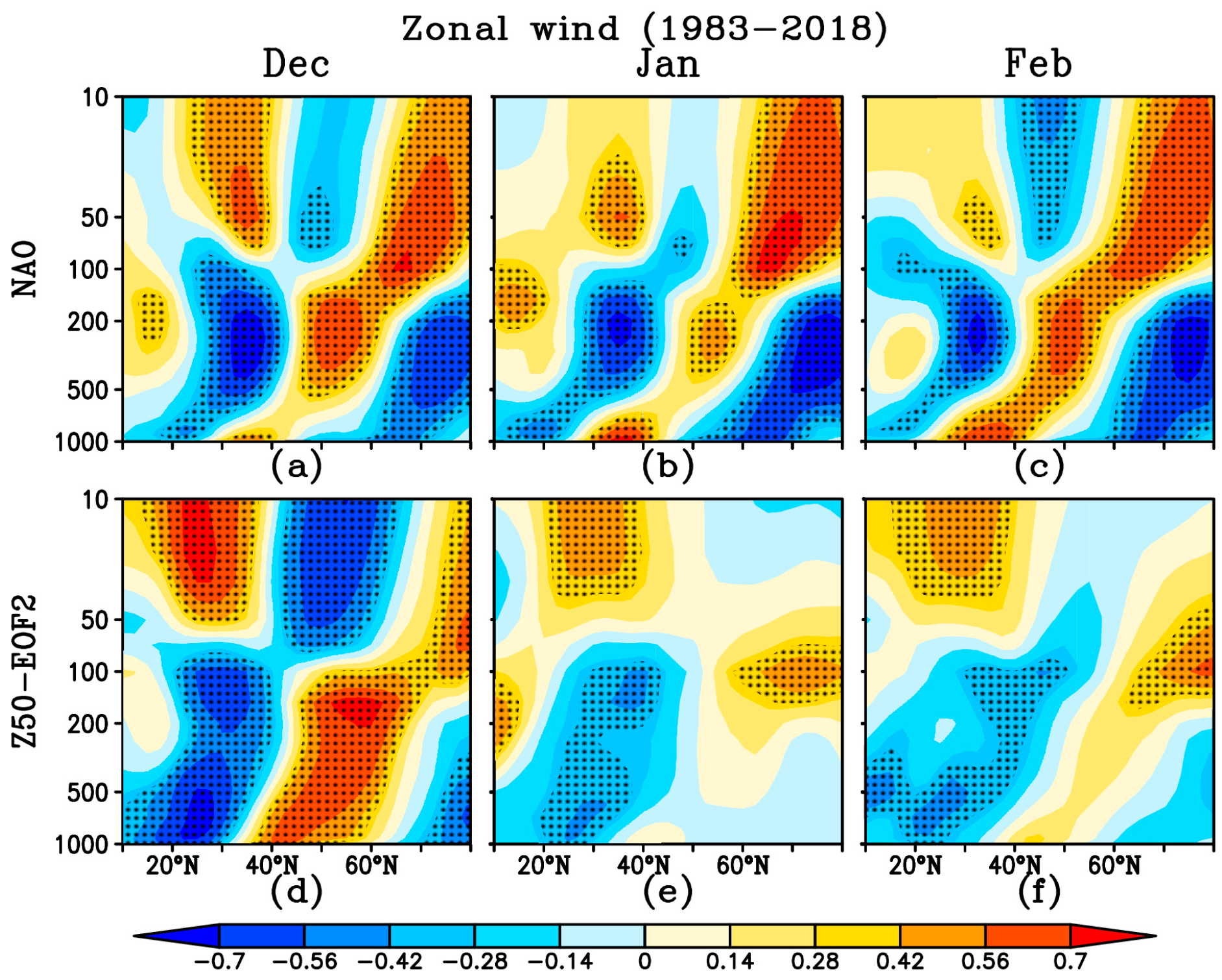
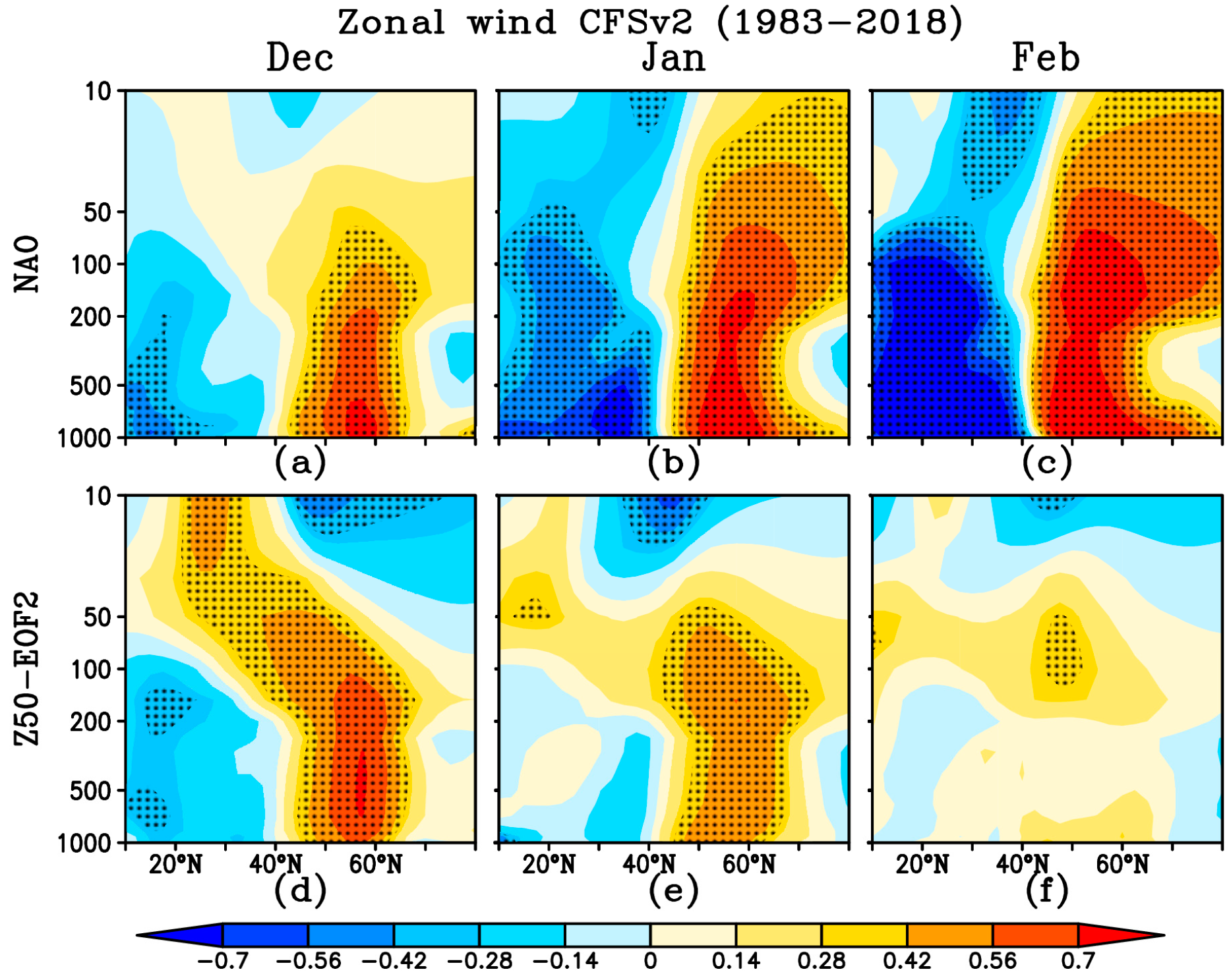
© 2019 by the authors. Licensee MDPI, Basel, Switzerland. This article is an open access article distributed under the terms and conditions of the Creative Commons Attribution (CC BY) license (http://creativecommons.org/licenses/by/4.0/).
Share and Cite
Tian, B.; Fan, K. Why is the North Atlantic Oscillation More Predictable in December? Atmosphere 2019, 10, 477. https://doi.org/10.3390/atmos10080477
Tian B, Fan K. Why is the North Atlantic Oscillation More Predictable in December? Atmosphere. 2019; 10(8):477. https://doi.org/10.3390/atmos10080477
Chicago/Turabian StyleTian, Baoqiang, and Ke Fan. 2019. "Why is the North Atlantic Oscillation More Predictable in December?" Atmosphere 10, no. 8: 477. https://doi.org/10.3390/atmos10080477
APA StyleTian, B., & Fan, K. (2019). Why is the North Atlantic Oscillation More Predictable in December? Atmosphere, 10(8), 477. https://doi.org/10.3390/atmos10080477



